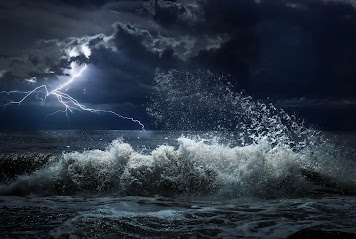How the strom tsunami biperjoy comes
Storms in the ocean, specifically tropical cyclones or hurricanes, typically form over warm ocean waters near the equator. Here's a general explanation of how storms develop in the ocean:
Warm ocean waters: Storms require warm ocean waters with temperatures above 26.5 degrees Celsius (80 degrees Fahrenheit) to provide the necessary energy for their formation and intensification. These warm waters act as fuel for the storm.
Evaporation: As the sun heats the ocean's surface, water molecules evaporate and rise into the atmosphere. This process increases the humidity in the air above the ocean.
Low-pressure system: In the presence of certain atmospheric conditions, a low-pressure system may develop over the warm ocean waters. Low pressure occurs when there is a relatively lower air density in a specific region compared to the surrounding areas. The warm, moist air rises and begins to rotate counterclockwise (in the Northern Hemisphere) due to the Earth's rotation and the Coriolis effect.
Formation of a tropical depression: As the low-pressure system intensifies, the rotating air column becomes more organized. It may develop a closed circular structure and sustained wind speeds of up to 38 miles per hour (62 kilometers per hour). At this stage, it is classified as a tropical depression.
Development into a tropical storm: If the tropical depression continues to strengthen, with sustained winds reaching speeds between 39 to 73 miles per hour (63 to 118 kilometers per hour), it is upgraded to a tropical storm. The storm is assigned a name at this point.
Hurricane formation: If favorable conditions persist, with warm water temperatures and low wind shear (the change in wind speed and direction with height), the tropical storm can continue to intensify. Sustained wind speeds exceed 74 miles per hour (119 kilometers per hour), and the storm is then classified as a hurricane or typhoon, depending on the region.
Storm movement: Once formed, hurricanes are steered by atmospheric patterns, including prevailing winds, high-pressure systems, and the rotation of the Earth. They can travel across vast distances, affecting coastal areas and sometimes moving into land, causing significant damage.
It's important to note that the exact formation and behavior of storms in the ocean can be influenced by various factors, including sea surface temperatures, wind shear, atmospheric stability, and interactions with land masses






Post a Comment